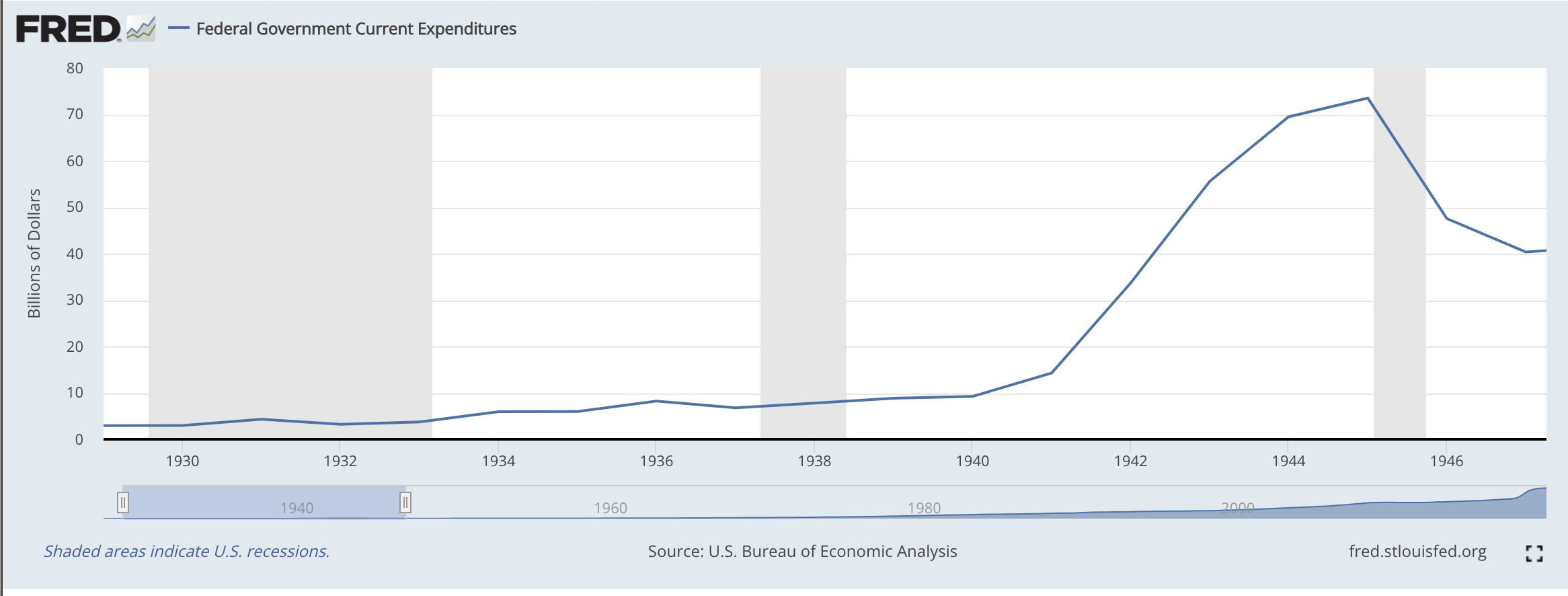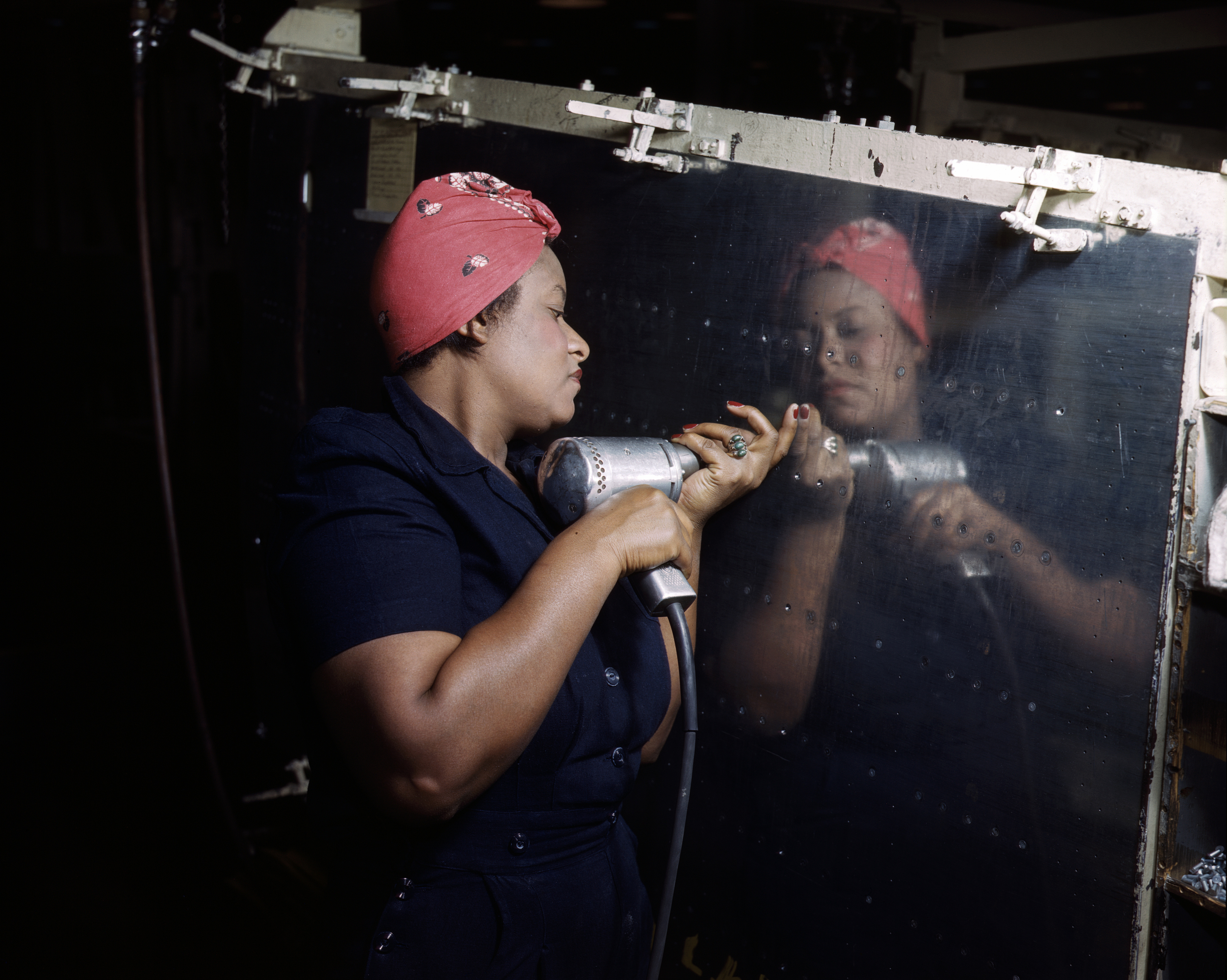Caleb Lagerwey
Robby May
AP US History 🇺🇸
454 resourcesSee Units
Arsenal of Democracy
The US entrance into WWII ended the Depression since the US quickly became, in the words of President FDR, the Arsenal of Democracy as it turned its production capacity toward making war matériel. This production supplied both the US military and its allies like the UK, China, and USSR. Facing a labor shortage because of the 15 million men and women in the armed services, unemployment virtually disappeared during the war.
The US produced an astonishing quantity of weapons and goods during the war. You should know a few examples of this. Liberty Ships were US cargo boats that were made cheaply and quickly, and they proved useful in moving men and matériel around the world during the war.
Four Freedoms
Addressing Congress on January 6, 1941, the president delivered a speech that proposed lending money to Britain for the purchase of US war materials. He justified such a policy by arguing that the US must help others nations defend “four freedoms:”
- Freedom of speech
- Freedom of religion
- Freedom from want
- Freedom from fear
This shifted World War II from a political war to an ideological war, one that wasn't against Germany per-se, but rather against fascism and Nazism as a whole. This helped to frame America as a fighter for democracy against fascism.
Mobilization
The US government raised taxes and sold bonds (loans by citizens to the US government) just like in WWI, but at an unprecedented level. The government also organized and supervised the US economy in new ways through rationing and through agencies like the War Production Board (WPB) and the Office of Price Administration (OPA) that controlled war industries (no cars; only tanks!) and consumer prices, respectively.
US industries did a booming business, far exceeding their production and profits of the 1920s. The depression was over and unemployment disappeared. Instead of automobiles, tanks and fighter planes rolled off the assembly lines. Henry Ford built the Willow Run factory, covering 67 acres, where 42,000 workers turned out a B-24 bomber every hour. A shipyard in California could turn out an entire ship in just 14 days.
The mobilization in preparation for World War II is largely considered the cause of the end of the Great Depression. Government expenditures and a need for labor decreased unemployment and began flowing money through the economy again. Check out the following graph that shows government spending between 1930 and the mid-1940s. You can see the massive increase between 1941 and 1945. That's World War II! The first two grey bars are the Great Depression and the Roosevelt Recession.

We'll talk a bit later about why there was a brief recession in 1945, but other than that, World War II pulled the US economy out of the dark.
The War & Women
Just like in WWI, the manpower shortage led to new opportunities for women and minorities, who worked in factories to replace the enlisted men.

Image Courtesy of Wikimedia
Some women joined the military as nurses, or joined the military’s non-combat units and became WACS (Women’s Air Corps), WAVES (Women Accepted for Volunteer Emergency Service, but officially the United States Naval Reserve [Women's Reserve]), and WASPS (Women Airforce Service Pilots).
Others worked at home on assembly lines. Rosie the Riveter became a symbol of women taking jobs in defense industry factories. These jobs were usually the first high-paying jobs they’d ever had, and some tried to stay in their posts even after the war was finished.

The War & African Americans
During World War II, African Americans were drafted into the military and were often placed in segregated units, which were led by white officers. This segregation was a reflection of the Jim Crow laws and practices that were in place in the United States at the time, which institutionalized racial segregation and discrimination against Black Americans. Despite the segregation, many African American soldiers fought with distinction, including the Tuskegee Airmen, who were a group of African American pilots who served in the U.S. Army Air Corps.
The Tuskegee Airmen faced numerous challenges and discrimination, but they persevered and became one of the most highly decorated units of World War II. Their bravery and determination inspired other African Americans to fight against racism not just abroad, but also at home. This led to the development of the Double V Campaign, which sought victory over fascism abroad and over racism at home.

A. Philip Randolph, a prominent Black leader and civil rights activist, played a significant role in the Double V Campaign. He used the threat of a march on Washington to pressure President Franklin D. Roosevelt to issue Executive Order 8802, which prohibited racial discrimination in defense industries. This was a significant step towards ending segregation and discrimination in the military and in the defense industry. Overall, the contributions of African Americans during World War II helped to bring about much needed change and paved the way for future civil rights struggles.

A. Philip Randolph
The War & Mexican-Americans
The Second World War also saw significant racial tension between White and Latinx people on the West Coast of the United States. One of the most notable incidents was the Zoot Suit Riots in Los Angeles, which occurred when white servicemen roamed Mexican-American neighborhoods, attacking Latinx people. The violence and discrimination faced by Latinx individuals during this time was a reflection of the racism and prejudice that was prevalent in society at the time.
To help address labor shortages during the war, the United States government implemented the Bracero Program, which recruited Mexican laborers to work in American agriculture. These workers were brought in to fill in for the missing white workers who were serving in the military. While the Bracero Program did provide much needed labor, it also led to further tension and resentment between White and Latinx communities.
Overall, the racial tension between White and Latinx people during World War II was a reflection of the broader issues of segregation and discrimination that were present in society at the time. Despite the challenges faced by Latinx individuals, many continued to fight for their rights and for equality, laying the groundwork for future civil rights struggles.
The War & Native Americans
During World War II, some Native American people saw new opportunities arise as a result of the conflict. One famous example of this was the Navajo Code Talkers, who were recruited by the United States military to serve as communication experts. The Navajo Code Talkers used their fluency in the Navajo language to transmit secret messages that were indecipherable to the enemy. This proved to be an extremely effective tactic, and the Navajo Code Talkers played a crucial role in the war effort.
The service of the Navajo Code Talkers is a testament to the bravery and patriotism of Native American people during World War II. Despite facing ongoing discrimination and challenges, many Native Americans were able to make significant contributions to the war effort and to their country. The legacy of the Navajo Code Talkers continues to be celebrated and honored today.
The War & Japanese Americans
The Japanese internment camps during World War II are a controversial and dark chapter in American history. Executive Order 9066, which was issued by President Franklin D. Roosevelt, authorized the internment of over 110,000 Japanese Americans on the West Coast of the United States. Over two-thirds of these individuals were U.S. citizens. The internment was motivated by a combination of war paranoia and longstanding discrimination against Asian Americans.
The internment camps were a form of mass detention, with Japanese Americans being forcibly removed from their homes and placed in camps for the duration of the war. Many lost their homes, businesses, and personal possessions as a result. Some Japanese Americans tried to challenge the internment order, but the Supreme Court upheld it in the landmark case of Korematsu v. United States (1944).
Despite the discrimination they faced, some Japanese American men were able to fight for the United States in the European theater. The 442nd Infantry Regiment, which was composed largely of Japanese Americans, became one of the most highly decorated units in American history for their service in fighting the Nazis.

🎥 Watch: AP US History - World War II
Browse Study Guides By Unit
🌽Unit 1 – Interactions North America, 1491-1607
🦃Unit 2 – Colonial Society, 1607-1754
🔫Unit 3 – Conflict & American Independence, 1754-1800
🐎Unit 4 – American Expansion, 1800-1848
💣Unit 5 – Civil War & Reconstruction, 1848-1877
🚂Unit 6 – Industrialization & the Gilded Age, 1865-1898
🌎Unit 7 – Conflict in the Early 20th Century, 1890-1945
🥶Unit 8 – The Postwar Period & Cold War, 1945-1980
📲Unit 9 – Entering Into the 21st Century, 1980-Present
📚Study Tools
🤔Exam Skills
👉🏼Subject Guides
📚AMSCO Notes

Fiveable
Resources
© 2025 Fiveable Inc. All rights reserved.